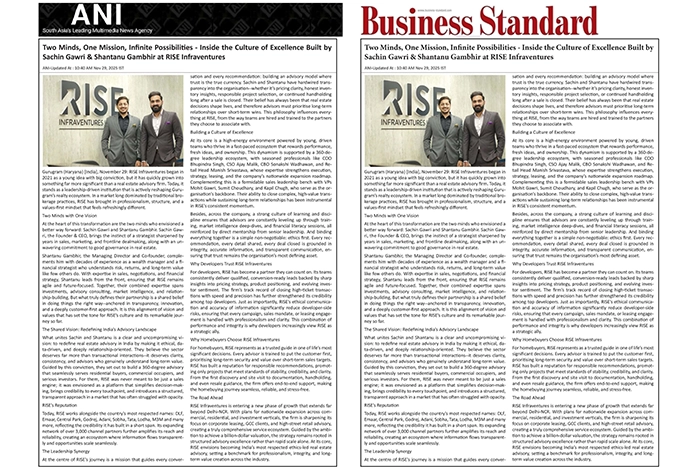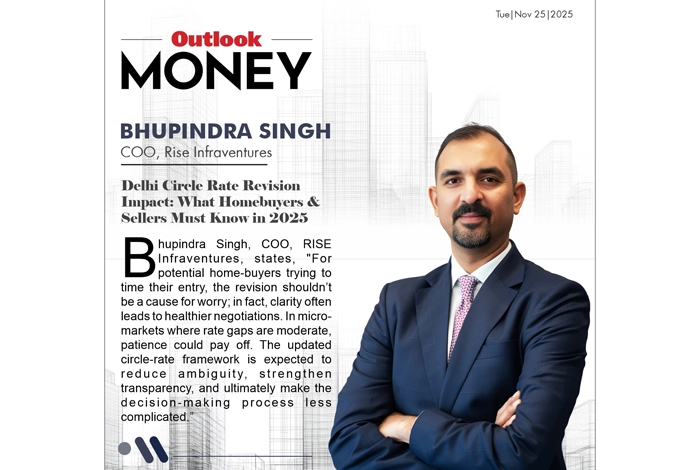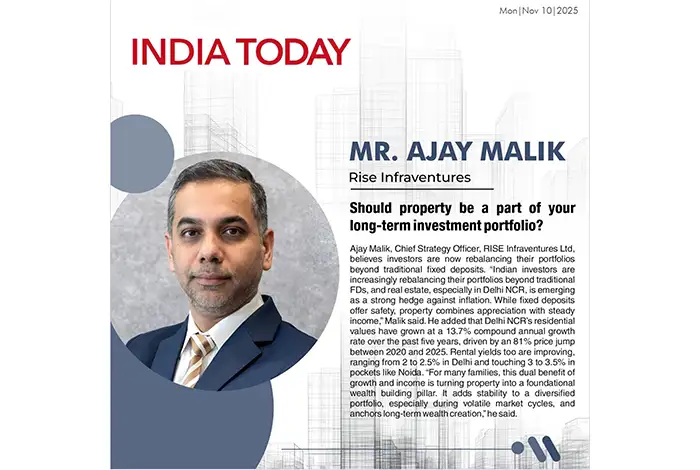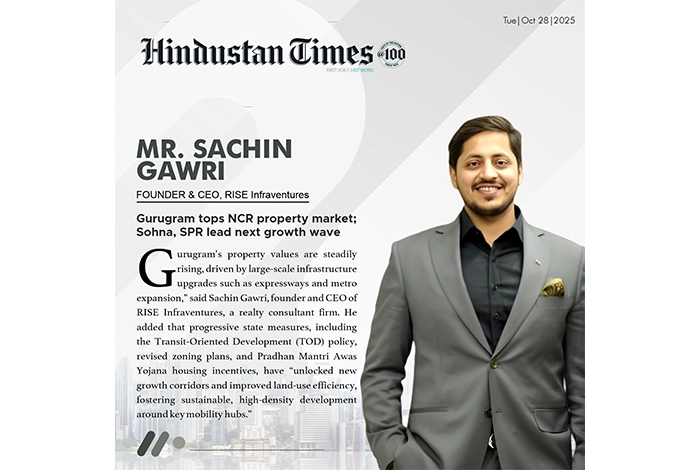India's Commercial Leasing Is Not Just a Metro Story; It Is Expanding to Tier-2 Cities: RISE Infra COO

Published by News18
"The retail sector is poised for an exceptional year, with leasing expected to surpass 10 million sq ft," says Bhupindra Singh, Chief Operating Officer of RISE Infraventures.
India's commercial real estate landscape is undergoing a massive transformation. While metro cities such as Delhi-NCR, Mumbai, and Bengaluru continue to dominate leasing activity, a parallel wave of expansion is reshaping the country's Tier-2 and Tier-3 cities. This shift marks a new era where smaller cities are becoming strong commercial hubs, fueled by infrastructure development, evolving consumer patterns, and growing investor confidence.
According to Bhupindra Singh, COO of RISE Infraventures, this trend reflects two simultaneous growth stories: one rooted in rebounding metros and the other emerging powerfully from India's fast-growing smaller cities.
Tier-1 vs. Tier-2 Cities: Two Sides of India's Leasing Growth
In major metros, commercial leasing has rebounded strongly, particularly in prime retail and F&B segments. Delhi-NCR alone witnessed a 69% jump in retail leasing, signalling a robust return of footfalls in malls and shopping centres. Yet, the nature of demand has evolved.
"Today, consumers do not just visit malls for shopping. They seek experiences such as dining, socialising, entertainment, and leisure." The food and beverage sector alone contributed more than 22% of NCR's leasing activity last quarter, highlighting the changing dynamics of urban consumption.
However, the most exciting development lies beyond the metros. Tier-2 cities such as Ayodhya, Lucknow, Prayagraj, and Varanasi are experiencing a surge in both commercial and hospitality demand. With spiritual tourism driving significant visitor inflows, developers are responding with serviced apartments, modern retail outlets, and premium hotels.
Singh notes, "It is not just about pilgrims anymore. Families want comfortable and modern experiences, and that is creating a ripple effect across retail and real estate." A new class of buyers is also emerging: professionals, entrepreneurs, and NRIs who prefer spacious, high-quality homes in Tier 2 cities over compact and expensive apartments in metro cities. This quiet luxury movement is transforming cities like Lucknow into preferred residential and business destinations.
Infrastructure: The Backbone of India's Commercial Expansion
The surge in commercial activity across smaller cities is closely linked to India's infrastructure revolution. Massive investments in expressways, metro networks, and airports are redrawing the country's economic map. Projects such as the Ganga Expressway have significantly reduced travel times, connecting remote cities with major economic corridors and making them attractive for both businesses and residents.
Singh explains, "You can't overstate the importance of infrastructure. Every expressway or airport not only improves connectivity but also boosts investor confidence." Areas within a 5 km radius of new infrastructure projects have seen land value appreciation between 40% and 60%, demonstrating the direct impact of development on real estate growth.
As metro extensions, airports, and highways open up, they create new micro-markets almost overnight, transforming once-quiet towns into vibrant commercial hubs. For developers and investors alike, infrastructure has become the most reliable indicator of where the next major commercial corridor will emerge.
Investor Interest Shifts: Beyond Offices to Retail and Warehousing
The commercial real estate investment landscape in India is becoming more diverse. While office spaces remain a solid and stable asset class, investors are increasingly turning to retail and warehousing for higher returns.
According to Singh, the retail sector is expected to cross 10 million sq ft in leasing this year, making it one of the country's most active segments. The revival of in-person shopping, experiential retail formats, and strong demand from international brands are driving this growth.
At the same time, warehousing and logistics real estate are booming, fueled by the rapid expansion of e-commerce and last-mile delivery networks. Investors are recognising the long-term potential in integrated developments, projects that combine retail, leisure, residential, and hospitality. Singh emphasises, "It's not just about returns; it's about investing in sustainable, self-contained ecosystems that can thrive independently."
Emerging Trends in the Next 2–3 Years
Several trends are set to define India's commercial leasing sector in the near future:
1. The Rise of the Experience Economy: Traditional malls are giving way to lifestyle destinations. Consumers now expect more than shopping; they seek entertainment, dining, and interactive experiences. This is driving developers to create mixed-use spaces that seamlessly integrate retail, food, and leisure.
2. The Great Dispersal: As property prices and saturation levels rise in Tier-1 cities, brands and investors are moving into Tier-2 and Tier-3 markets. Cities like Ayodhya, Indore, and Jaipur are emerging as models for this trend, offering affordability, growth potential, and untapped demand.
3. Sustainability and Smart Spaces: Green and smart features are no longer optional. Tenants expect energy-efficient, tech-enabled, and wellness-focused environments. From smart lighting to air-quality monitoring, these features are quickly becoming standard in premium commercial developments.
RISE Infraventures: Bridging Investors and Opportunities
RISE Infraventures has established itself as a key player in connecting investors with high-growth markets. Singh describes the company's role as a bridge, helping investors, both domestic and international, make informed decisions based on data-driven insights and on-ground intelligence.
"Our strength lies in our local networks and transactional data," Singh explains. “We track leasing trends before they hit headlines. Whether it's the 69% retail surge in NCR or land value growth near Ayodhya's temple belt, our team knows which developers deliver quality and where the next high-return micro-market will emerge.â€
By leveraging deep market analytics, RISE Infra identifies Grade-A assets across retail, office, and warehousing segments, helping investors achieve both growth and stability. The company's approach aligns with India's ongoing transition, where commercial leasing is no longer confined to metro skylines but is expanding into new economic corridors across the country.
Conclusion: The Future of Commercial Leasing in India
The story of commercial leasing in India is evolving. It's no longer just about big cities and high streets. Tier-2 and Tier-3 cities are emerging as strong contenders, driven by infrastructure, changing lifestyles, and robust investor interest. From Delhi-NCR's booming retail sector to the luxury markets in Lucknow and Ayodhya, commercial growth is spreading widely across the country.
As Singh concludes, "This is just the beginning. The real estate future belongs to the cities that are building, connecting, and evolving faster than ever before."
Frequently Asked Questions
1. How is commercial leasing evolving in India beyond metro cities?
Commercial leasing in India is expanding rapidly into Tier-2 and Tier-3 cities, driven by infrastructure development, spiritual tourism, and rising demand for modern retail and residential spaces.
2. Which cities are emerging as new commercial hubs in India?
Cities like Ayodhya, Lucknow, Prayagraj, and Varanasi are becoming strong commercial destinations, attracting both retail, hospitality, and residential investments.
3. What role does infrastructure play in commercial real estate growth?
Infrastructure projects like expressways, metro lines, and airports are boosting connectivity, increasing land values, and creating new micro-markets in Tier-2 cities.
4. Which commercial sectors are attracting the most investor interest?
Retail, warehousing, and integrated developments are seeing strong investment interest, with the retail sector expected to surpass 10 million sq ft in leasing this year.
5. What are the future trends in India's commercial leasing market?
Key trends include the rise of the experience economy, expansion into Tier-2 and Tier-3 cities, and the demand for sustainable and smart commercial spaces.





